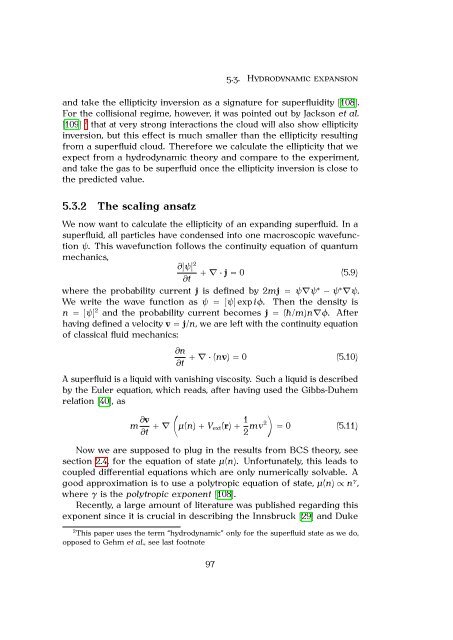Martin Teichmann Atomes de lithium-6 ultra froids dans la ... - TEL
Martin Teichmann Atomes de lithium-6 ultra froids dans la ... - TEL
Martin Teichmann Atomes de lithium-6 ultra froids dans la ... - TEL
Create successful ePaper yourself
Turn your PDF publications into a flip-book with our unique Google optimized e-Paper software.
5.3. HYDRODYNAMIC EXPANSION<br />
and take the ellipticity inversion as a signature for superfluidity [108].<br />
For the collisional regime, however, it was pointed out by Jackson et al.<br />
[109] 2 that at very strong interactions the cloud will also show ellipticity<br />
inversion, but this effect is much smaller than the ellipticity resulting<br />
from a superfluid cloud. Therefore we calcu<strong>la</strong>te the ellipticity that we<br />
expect from a hydrodynamic theory and compare to the experiment,<br />
and take the gas to be superfluid once the ellipticity inversion is close to<br />
the predicted value.<br />
5.3.2 The scaling ansatz<br />
We now want to calcu<strong>la</strong>te the ellipticity of an expanding superfluid. In a<br />
superfluid, all particles have con<strong>de</strong>nsed into one macroscopic wavefunction<br />
ψ. This wavefunction follows the continuity equation of quantum<br />
mechanics,<br />
∂|ψ| 2<br />
+ ∇ · j = 0 (5.9)<br />
∂t<br />
where the probability current j is <strong>de</strong>fined by 2mj = ψ∇ψ∗ − ψ∗∇ψ. We write the wave function as ψ = |ψ| exp iφ. Then the <strong>de</strong>nsity is<br />
n = |ψ| 2 and the probability current becomes j = (¯h/m)n∇φ. After<br />
having <strong>de</strong>fined a velocity v = j/n, we are left with the continuity equation<br />
of c<strong>la</strong>ssical fluid mechanics:<br />
∂n<br />
∂t<br />
+ ∇ · (nv) = 0 (5.10)<br />
A superfluid is a liquid with vanishing viscosity. Such a liquid is <strong>de</strong>scribed<br />
by the Euler equation, which reads, after having used the Gibbs-Duhem<br />
re<strong>la</strong>tion [40], as<br />
m ∂v<br />
∂t<br />
�<br />
+ ∇ µ(n) + Vext(r) + 1<br />
2 mv2<br />
�<br />
= 0 (5.11)<br />
Now we are supposed to plug in the results from BCS theory, see<br />
section 2.4, for the equation of state µ(n). Unfortunately, this leads to<br />
coupled differential equations which are only numerically solvable. A<br />
good approximation is to use a polytropic equation of state, µ(n) ∝ n γ ,<br />
where γ is the polytropic exponent [108].<br />
Recently, a <strong>la</strong>rge amount of literature was published regarding this<br />
exponent since it is crucial in <strong>de</strong>scribing the Innsbruck [29] and Duke<br />
2 This paper uses the term “hydrodynamic” only for the superfluid state as we do,<br />
opposed to Gehm et al., see <strong>la</strong>st footnote<br />
97

















